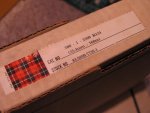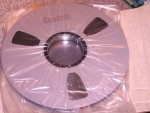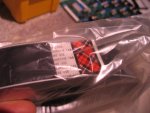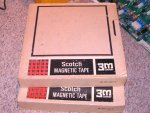I know the stereo image on the 206 also "comes in" a little, if that makes sense. Maybe that's the "glue".
By "comes in" you mean the soundstage narrows?
And I tend to think of "glue" in this area as a mix that just fits together better...that
works better...
My understanding though is that 206 and SM911 are bias compatible...
Well, um, I'm kind of surprised at that but I've got a lot to learn in interpreting the specs.
The coercivity of the two is the same at 320 oersteds...I read that coercivity is the measure of the flux required to reduce a magnetic medium to a neutral state when that medium is charged to saturation...kind of like how hard the medium holds on to its magnetic state.
The retentivity of the two is quite different; 1050 gauss for the 206 and 1450 for the SM911...I read that retentivity is the measure of flux level remaining on the medium compared to a known magnetic charge, IOW how well the medium
retains the flux level to which it is exposed and in this case that would be the flux present at the record head during recording. I'm seeing this as sort of a measure of efficiency...what level of flux remains on tape after it passes a given flux level at the record head.
The Oxide thickness is pretty close...0.56mils for 206 and 0.63mils for SM911.
So where does that leave us? I dunno, but there are differences in the specifications, and its hard to imagine that they'd be totally bias compatible. Certainly they perform differently, they sound significantly different on your 42 all settings being the same...and note that the specifications charts don't cover the oxide formula itself...what it is made of...what percentages of what and so on and that in and of itself effects how the tape performs and what is required for optimum performance.
I go back to Quampex 457 and BASF/EMTEC/RMGI LPR35...this is related to my recent experiments on my 388. The manual says to set the bias amp output to 150mV for proper biasing of the tape. That was for 457. My testing resulted in a nominal setting of about 115mV for LPR35 using the LF modulation method. There's more detail in my Tascam 388 Story thread, but those are both "1mil +6" tapes. They ain't bias compatible, and from a marketing standpoint they are a much more similar pair of tapes than 206 and SM911.
I like the idea of trying a tone ladder on the tapes. I am not sure I can measure accurately though. I have a Fluke 114. It says True RMS, but I don't think it is "true" True RMS.
If it sez "true RMS" it is true RMS reading, 'nuf sed.
Looking at the manual for the 114 the catch is that it is only reasonably acurate from about 45Hz to 1kHz...that's the window of accuracy for the AC voltage section, so Fluke is saying "we don't gaurantee the accuracy outside of that frequency range." I'd say forget measuring HF tones with it. Great meter for general use though and certainly you can use it to setup and verify levels at 1kHz and get an idea of what is happening down into the LF range...see where your head bump is and all that. See if you know anybody that has something like a Fluke 83, 85 or 87 you can borrow and then you can note the deviation of your meters at high frequencies and then just use the meters after that mentally adjusting for the deviation.
While I'm in there, I may try experimenting with some other tapes I have as well. I have some older NOS BASF LP35 and even older NOS BASF LGS 35. I don't think these are bias compatible with the 206/SM911 though.
No, I wouldn't think so.
As far as re-biasing, do I have to recalibrate the entire deck, or only the bias steps and thereafter?
Assuming you are okay hitting different tape types (i.e. +0, +3, +6 etc.) with the same nominal level, or adjusting mentally what you are treating as "0" on the meters, there is no reason to recalibrate the levels of the electronics. And I figure if you have the electronics adjusted for resonably flat response with one tape type properly biased, then rebiasing to another tape type should keep you in the same response curve neighborhood save for the individual anomalies or character of the different tapes. Does that make sense?
Good stuff. Have fun!





